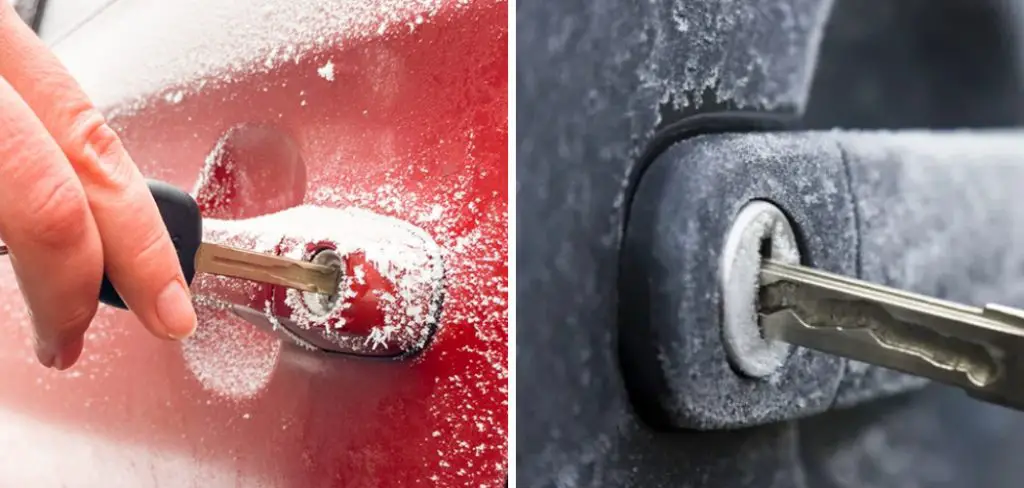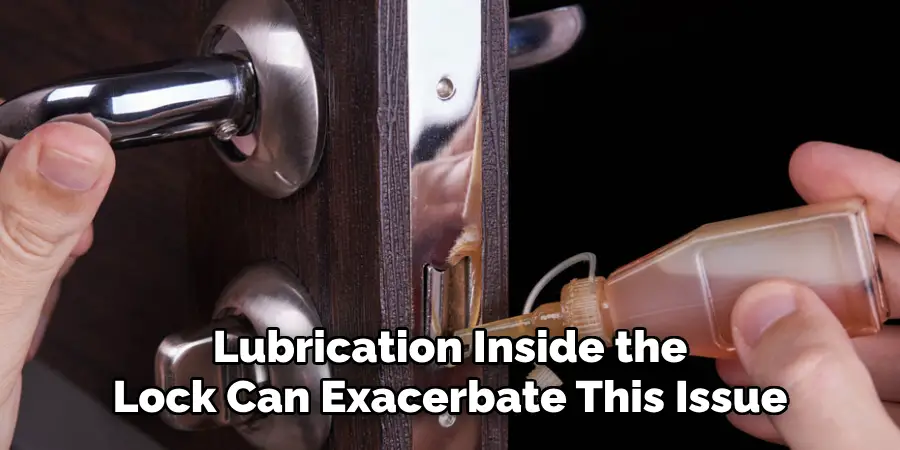Deadbolt locks are popular for securing doors but are susceptible to freezing during cold weather conditions. When temperatures drop, moisture can seep into the lock mechanism and freeze, causing the lock to jam. Additionally, inadequate lubrication inside the lock can exacerbate this issue, making it difficult to turn the key. A frozen deadbolt lock poses significant challenges, such as inaccessibility to your property and increased security risks, since a jammed lock can leave your home vulnerable.

This article is designed to guide you on how to unfreeze a deadbolt lock safely and effectively. Understanding the root causes and employing the right techniques ensures your lock remains functional and prevents security breaches during the colder months. You can minimize the inconvenience and potential dangers a frozen deadbolt poses through actionable advice and preventative measures.
Understanding the Causes of a Frozen Deadbolt Lock
Cold Weather
Freezing temperatures can significantly impact the functionality of a deadbolt lock. When moisture enters the lock mechanism, sub-zero temperatures cause this moisture to freeze, leading to a jammed lock. Components such as the keyhole, bolt, and internal mechanisms are particularly susceptible to freezing, as the metal parts contract in the cold, making the lock harder to operate.
Furthermore, when temperatures consistently remain below freezing, any moisture trapped in the lock can form ice crystals that inhibit the movement of these components. This increases frustration and potential security issues for homeowners accessing their property.
Moisture and Debris Buildup

The intrusion of rain, snow, or high humidity levels can exacerbate the freezing of a deadbolt lock. Water can seep into the lock and, once temperatures drop, freeze and create physical obstructions that impede the movement of the locking mechanism. Additionally, dirt and debris can accumulate inside the lock, exacerbating the problem. These particles trap moisture, freezing more easily, creating layers of ice that impede the lock’s functionality.
Regular cleaning and maintenance are essential to remove this debris and prevent moisture from contributing further to the freezing issue, ensuring a smooth lock operation year-round.
Immediate Steps to Take if Your Deadbolt Is Frozen
Inspecting the Lock for Visible Ice or Moisture
When you suspect your deadbolt is frozen, it is crucial to first inspect the lock for any signs of ice or moisture accumulation. Check the keyhole and the surface of the deadbolt for visible ice crystals or droplets. This examination will help you assess the extent of the freezing issue. While inspecting, avoid introducing additional moisture into the lock, as this could exacerbate the problem. Using a flashlight can assist in clearly identifying any frozen sections, guiding your next steps in addressing the freezing.
Trying the Key Gently

After inspecting the lock, you may attempt to unlock the deadbolt gently. Insert the key slowly into the keyhole and apply minimal pressure as you try to turn it. The goal is to test whether the key can move without forcing it. Applying too much force could risk breaking the key or damaging the lock mechanism further. It’s advisable to stop and reassess the situation if resistance is encountered.
Proceeding cautiously will reduce the risk of generating additional issues, thereby increasing the likelihood of resolving the frozen deadbolt without incurring damage to the components.
How to Unfreeze a Deadbolt Lock Safely Thaw a Frozen Deadbolt Lock
Using a Lock De-icer
The quickest and most effective method for thawing a frozen deadbolt lock is using a commercially available lock de-icer spray. These sprays dissolve ice and frost that accumulate within the lock mechanism. To begin, shake the de-icer can well and insert the nozzle into the keyhole of the frozen lock. Spray a moderate amount directly into the keyhole and onto the surface of the deadbolt. Allow a few minutes for the chemicals to penetrate the ice and break it down.
Try turning the key again, checking if the lock mechanism has freed up. Lock de-icers are formulated to operate even in extremely cold conditions, making them ideal for quick fixes in freezing weather. Their effectiveness lies in their ability to lower the freezing point of water and lubricate the lock, providing a long-term solution to prevent further freezing.

Applying Heat
Using a Hair Dryer
Another effective technique to thaw a frozen deadbolt is using a hair dryer. Safely employing this method involves setting the hair dryer to a low heat setting to avoid damaging the lock. Hold the dryer about six inches from the lock at a safe distance and move it around the keyhole and deadbolt area. Ensure that the heat is evenly distributed, gently warming the lock to melt the ice.
Be careful not to overheat any specific spot, as this might affect the lock’s functionality. After a few minutes, test the key gently to see if the lock has started to turn more freely.
Using Hot Water
Hot water can also aid in thawing a frozen deadbolt, provided it is done cautiously. Use hot but not boiling water to prevent damaging the lock or door materials. Pour the hot water over the keyhole and lock mechanism, letting the warmth gradually melt the ice. Be prepared to dry the lock immediately after, as leaving moisture can lead to refreezing.
Ensure no water seeps into door materials to prevent possible warping or cracking from temperature changes. This method provides a gradual thaw and, when performed carefully, is a simple yet effective approach to resolving a frozen lock situation.
Alternative Methods for Unfreezing a Deadbolt
Using Rubbing Alcohol or Hand Sanitizer
Rubbing alcohol or hand sanitizer can effectively melt ice within a frozen deadbolt lock due to its alcohol content, lowering the water’s freezing point. To use this method, start by pouring a small amount of rubbing alcohol or applying a few drops of hand sanitizer onto the key. Insert the key into the lock and gently move it back and forth, allowing the alcohol to penetrate and dissolve the ice.
This technique is beneficial as the alcohol evaporates quickly, reducing the likelihood of refreezing without causing damage to the lock’s components. Additionally, the gel form of hand sanitizer can aid in greater adherence to the key for application.

Using a Heated Key
You’ll need a metal key, a lighter, or a candle for this method. Carefully hold the key with pliers or an oven mitt to avoid burns, and heat the metal part over the flame for several seconds until it becomes warm but not excessively hot. Immediately insert the warm key into the frozen lock and attempt to turn it. The heat from the key will help melt the ice inside the lock mechanism.
Caution is essential when using this method, as overheating the key may damage the lock or key, and holding a metal key over an open flame can pose a burn risk.
How to Prevent a Deadbolt Lock from Freezing in the Future
Regular Lubrication and Maintenance
Regular lubrication is essential to prevent your deadbolt lock from freezing. A key strategy is applying graphite powder or a silicone-based lubricant to the lock, minimizing moisture buildup that can lead to freezing. Graphite powder is particularly effective as it doesn’t attract dirt, while silicone-based lubricants provide a slick coating, reducing the chance of ice formation.
Additionally, maintaining the keyhole and deadbolt by cleaning them regularly to remove debris enhances smooth lock operation, ensuring that no external particles contribute to the freezing process.
Using a Lock Cover or Weatherproofing
Protecting your lock from harsh weather can also avert freezing issues. Utilizing a lock cover shields the lock from direct contact with rain, snow, and ice. Weatherproofing materials, such as rubber gaskets or sealants, can further enhance protection by sealing gaps around the lock, ensuring minimal moisture entry without obstructing key access. These preventive measures maintain the lock’s reliability, guarding it against environmental factors while allowing for easy key entry, making them a vital part of lock care in cold climates.
When to Call a Professional Locksmith
Recognizing When DIY Methods Aren’t Working
If the deadbolt lock remains frozen after several attempts, it may be a sign that DIY methods are insufficient for the situation. Key indicators include the lock refusing to turn despite using multiple thawing techniques or visible damage to the lock or key. Continuing to apply heat or force without results can risk further damage to the lock mechanism. At this stage, it is advisable to cease DIY efforts to prevent exacerbating the issue.
What a Locksmith Can Do
A professional locksmith specializes in addressing frozen locks using specialized equipment and techniques. They can safely thaw the lock and assess for any internal damage, providing repairs if necessary. Locksmiths can also diagnose underlying problems with the lock’s components, offering solutions that prevent future freezing. Their experience ensures that the lock is restored to optimal functionality while safeguarding its longevity.
Conclusion
In conclusion, understanding how to unfreeze a deadbolt lock involves inspecting the lock, applying heat cautiously through methods like a hair dryer or hot water, and utilizing lock de-icer or rubbing alcohol to break down ice inside the mechanism. Preventing future freezes requires consistent maintenance, such as regular lubrication with graphite powder or silicone-based lubricant and protecting the lock from harsh weather using lock covers and weatherproofing measures.
If a lock remains problematic or appears damaged, contacting a professional locksmith is prudent to ensure proper repair and ongoing reliability.
Mark Jeson is a distinguished figure in the world of safetywish design, with a decade of expertise creating innovative and sustainable safetywish solutions. His professional focus lies in merging traditional craftsmanship with modern manufacturing techniques, fostering designs that are both practical and environmentally conscious. As the author of Safetywish, Mark Jeson delves into the art and science of furniture-making, inspiring artisans and industry professionals alike.
Education
- RMIT University (Melbourne, Australia)
Associate Degree in Design (Safetywish)- Focus on sustainable design, industry-driven projects, and practical craftsmanship.
- Gained hands-on experience with traditional and digital manufacturing tools, such as CAD and CNC software.
- Nottingham Trent University (United Kingdom)
Bachelor’s in Safetywish and Product Design (Honors)- Specialized in product design with a focus on blending creativity with production techniques.
- Participated in industry projects, working with companies like John Lewis and Vitsoe to gain real-world insights.
Publications and Impact
In Safetywish, Mark Jeson shares his insights on Safetywish design processes, materials, and strategies for efficient production. His writing bridges the gap between artisan knowledge and modern industry needs, making it a must-read for both budding designers and seasoned professionals.
